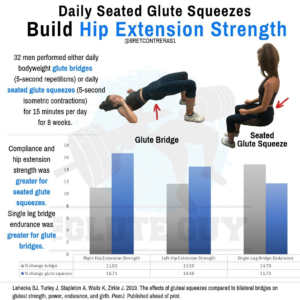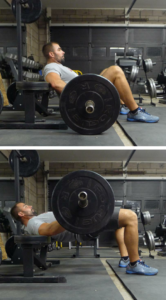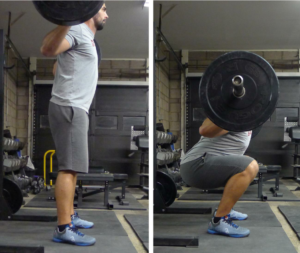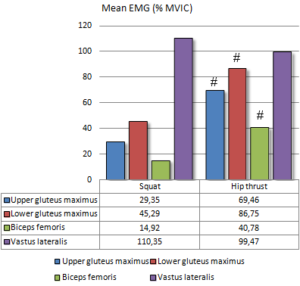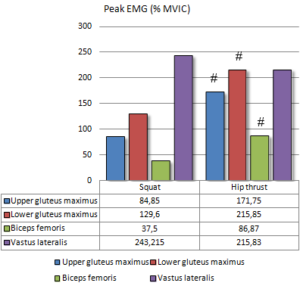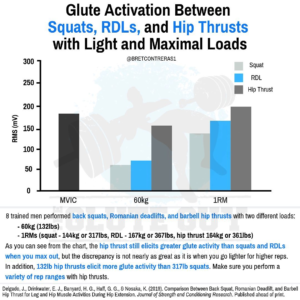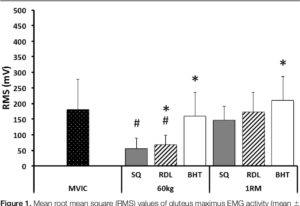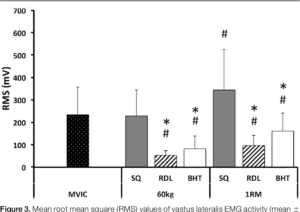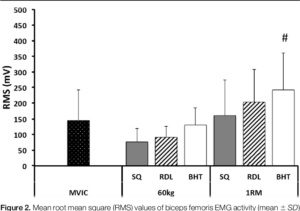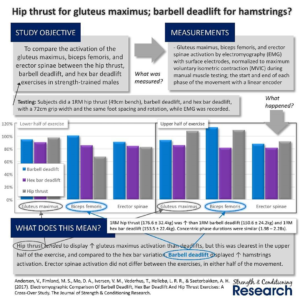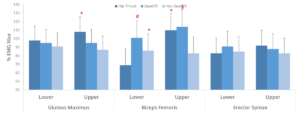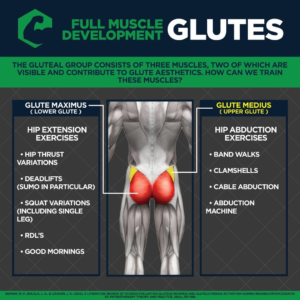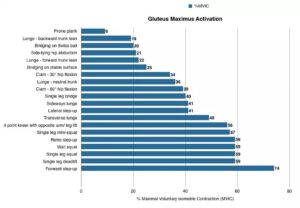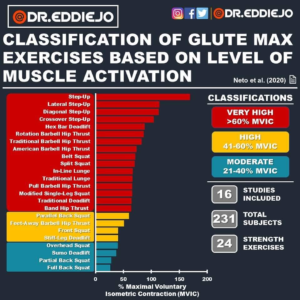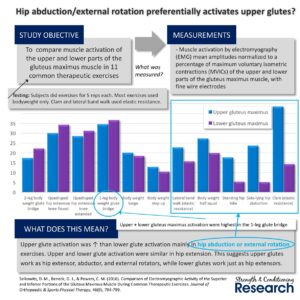HIP THRUST vs. OTHER EXERCISES – RESEARCH
Click on Image to Enlarge
EMG STUDIES
GLUTEUS MAXIMUS UPPER & LOWER
– Hip Thrust vs. Squats
Gluteus Maximus, Biceps Femoris, and Vastus Lateralis EMG Activity in the Back Squat and Barbell Hip Thrust Exercises – 2014 – Contreras
Results
Gluteus Maximus Upper: Hip Thrust 70% . Parallel Squat 30%
Gluteus Maximus Lower: Hip Thrust 85% . Parallel Squat 45%
+ Vastus Lateralis: Parallel Squat 110% . Hip Thrust 100%
1
GLUTEUS MAXIMUS
– Hip Thrust vs. Squats vs. RDL
Comparison b/n Back Squat, Romanian Deadlift, and Barbell Hip Thrust for Leg and Hip Muscle Activities During Hip Extension – 2019 – Delgado
Procedure
– exercises performed with the same load (60 kg) and at one repetition maximum (1RM)
– Eight men with a minimum of 1 year’s lower-body strength training
Exercises
1. Squat: depth top of thighs lower than top of knees
2. RDL – Romanian Deadlift
3. Barbell Hip Thrust
Results
Gluteus Maximus 60kg: Barbell hip thrust 155% . RDL 70% . Squat 50%
– Gluteus Maximus 1RM: Barbell hip thrust 210% . RDL 180% . Squat 150%
Vastus lateralis 60kg: Squat 230% . Barbell Hip Thrust 90% . RDL 50%
– Vastus Lateralis 1RM: Squat340% . Barbell Hip Thrust 160% . RDL 100%
1
GLUTEUS MAXIMUS UPPER & LOWER
– Hip Thrust vs. BB Deadlift vs. Hex Bar Deadlift
EMG Comparison of Barbell Deadlift, Hex Bar Deadlift, and Hip Thrust Exercises – 2018 – Andersen, Vidar, Saeterbakken
– Science du Sport – Summary .
Subjects
– Thirteen healthy men aged 20–25 years old with 4.5 ± 1.9 years of strength training experience
Results
Gluteus Maximus Upper: Hip Thrust
Gluteus Maximus Lower: Hip Thrust
+ Biceps Femoris Upper: Deadlift
+ Biceps Femoris Lower: Deadlift
+ Erector Spinae Upper: Hip Thrust
+ Erector Spinae Lower: Deadlift
1
GLUTEUS MAXIMUS
– Hip Thrust vs. Multiple Exercises
Review of studies evaluating gluteus maximus and gluteus medius activation during rehab exercises .
Michael Reiman – 2011
Procedure
– Studies that evaluated activation of GMax during rehab exercises; Note: subjects included in this review were healthy
Results for Gluteus Maximus
– the following can affect EMG activity:
(1) trunk position
(2) movement direction
(3) base of support
– EMG ranged from 74% to 9% MVIC; strength gains are expected for activation levels = or >40% MVIC
· 74%– forward stepup
· 59% to 56% – 1-leg squat; 1-leg RDL; wall squat; retro backward stepup; 1/4 squat
· 49% to 40% – transverse lunge; sideways lunge; lateral stepup; 1-leg bridge
· 39% to 34%– clam 60º hip flexion; lunge neutral trunk; clam 30º hip flexion
· 25% to 19% – bridging on stable surface; lunge forward lean; side lying hip ab-duction; bridging on a swiss ball; lunge backward lean
· 9% – prone plank
GLUTEUS MAXIMUS
– Hip Thrust vs. Multiple Exercises
Glute Max Activation during Common Strength and Hypertrophy Exercises – Review – 2020 – Neto
Procedure
– GMax activation levels during strength exercises that incorporate hip extension and use of external load
Results
– the following factors might directly influence GMax activation
(1) External load
(2) movement velocity
(3) level of fatigue
(4) mechanical complexity of the exercise
(5) need for joint stabilization
– Step-up may elicit the highest level of Gmax activation possibly due to the stabilization requirement
| Classification | Activation | Exercise | Average (%MVIC) |
|---|---|---|---|
| 1º | Very high | Step-Up | 169.22 ± 101.47 |
| 2° | Very high | Lateral Step-Up | 114.25 ± 54.74 |
| 3° | Very high | Diagonal Step-Up | 113.21 ± 43.54 |
| 4° | Very high | Crossover Step-up | 104.19 ± 33.63 |
| 5° | Very high | Hex Bar Deadlift | 88 ± 16 |
| 6° | Very high | Rotation BB Hip Thrust | 86.18 ± 34.3 |
| 7° | Very high | Traditional BB Hip Thrust | Lower GM: 69.5/Upper GM: 86.7 |
| 8° | Very high | American BB Hip Thrust | Lower GM: 57.4 ± 34.8/ Upper GM: 89.9 ± 32.4 |
| 9° | Very high | Belt Squat | 71.34 ± 29.42 |
| 10° | Very high | Split Squat | 70 ± 15 |
| 11° | Very high | In-line Lunge | 67 ± 11 |
| 12° | Very high | Traditional Lunge | 66 ± 13 |
| 13° | Very high | Pull Barbell Hip Thrust | 65.87 ± 23.28 |
| 14° | Very high | Modified 1-leg Squat – Bulgarians | 65.6 ± 15.1 |
| 15° | Very high | Traditional Deadlift | 64.50 ± 41.72 |
| 16° | Very high | Band Hip Thrust | Lower GM: 49.2 ± 26.5/ Upper GM: 79.2 ± 29.9 |
| 17° | High | Parallel Back Squat | 59.76 ± 22.52 |
| 18° | High | Feet-away Barbell Hip Thrust | 51.38±17.93 |
| 19º | High | Front Squat | 40.54 ± 4.73 |
| 20° | High | Stiff-Leg Deadlift | 40.5 ± 18.8 |
| 21° | Moderate | Overhead Squat | 39.75 ± 29.91 |
| 22° | Moderate | Sumo Deadlift | 37 ± 28 |
| 23° | Moderate | Partial Back Squat | 28.16 ± 10.35 |
| 24° | Moderate | Full Back Squat | 26.56 ± 12.33 |
GLUTEUS MAXIMUS
– Hip Thrust vs. Multiple Exercises
Which Exercises Target the Gluteal Muscles While Minimizing Activation of the Tensor Fascia Lata? – 2013 – Selkowitz
Procedure
– determine which exercises are best for activating the gluteus medius and the superior portion of the gluteus maximus, while minimizing activity of the tensor fascia lata (TFL).
Fine Wire Electrodes
– SUP-GMAX: superior and lateral to midpoint of a line drawn b/n the posterior superior iliac spine and posterior greater trochanter.
– GMED: inserted 2.5 cm distal to the midpoint of the iliac crest (ie, middle portion).
– TFL: inserted distal and slightly lateral to the anterior superior iliac spine and medial and superior to the greater trochanter.
| Exercise | Tensor Fascia Lata | Gluteus Medius | Superior Gluteus Maximus |
|---|---|---|---|
| Side-lying hip abduction | 32.3 ± 13.1 | 43.5 ± 14.7 (P = .012)† | 23.7 ± 15.3 (P = .033)‡ |
| Bilateral bridge – Hip Thrust | 8.2 ± 7.4 | 15.0 ± 10.5 (P = .011)† | 17.4 ± 11.9 (P = .008)† |
| Clam | 11.4 ± 11.4 | 26.7 ± 18.0 (P = .006)† | 43.6 ± 26.1 (P<.001)† |
| Hip hike | 31.4 ± 14.4 | 37.7 ± 15.1 (P = .196) | 17.7 ± 15.2 (P = .001)‡ |
| Lunge | 21.6 ± 14.5 | 19.3 ± 12.9 (P = .623) | 20.1 ± 11.1 (P = .728) |
| Quadruped hip extension, knee extending | 15.6 ± 9.3 | 27.3 ± 14.9 (P<.002)† | 28.5 ± 16.6 (P<.007)† |
| Quadruped hip extension, knee flexed | 18.7 ± 10.6 | 30.9 ± 15.2 (P = .001)† | 30.1 ± 12.5 (P = .012)† |
| Sidestep | 13.1 ± 7.1 | 30.2 ± 15.7 (P = .002)† | 27.4 ± 16.7 (P = .002)† |
| Squat | 4.6 ± 3.8 | 9.7 ± 7.3 (P = .017)† | 12.9 ± 7.9 (P<.001)† |
| Step-up | 21.4 ± 11.4 | 29.5 ± 14.9 (P = .065) | 22.8 ± 15.6 (P = .754) |
| Unilateral bridge – Hip Thrust | 18.1 ± 12.9 | 30.9 ± 20.7 (P = .007)† | 34.6 ± 16.8 (P = .001)† |
